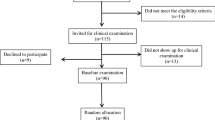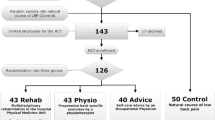Abstract
The purpose of this study was to demonstrate the effect of a once a week exercise program focused specially at lumbar extensor strengthening. This is a comparative study where workers volunteered to exercise were compared to workers who did not exercise. Low back claims for one year were noted to document efficacy of the training program. Change in strength was also noted. There was a 54% to 104% increase in strength during a 20 week program. The incidence of back injuries in the exercise group was 52 injuries per 200,000 employee hours versus the industry average of 1.09 back injuries per 200,000 employee hours. The average incidence of injury for the previous nine years at the company participating in the program was 2.94 injuries per 200,000 employee hours. The injury incidence in the workers not exercising was 2.55 injuries for 200,000 employee hours. The average workers' compensation liability dropped from $14, 430.00 per month to $380.00 per month for the study year. The significant increase in strength associated with the exercise program correlated with the greatly reduced incidence of back claims.
Similar content being viewed by others
References
Nachemson A, Lindh M. Measurement of abdominal and back muscle strength with and without low back pain.Scand J Rehab Med 1969; 1: 60–65.
Karvonen MJ, Viitasalo JT, Komi PV, Nummi J, Jarvinen T. Back and leg complaints in relation to muscle strength in young men.Scand J Rehab Med 1980; 12: 53–59.
Thorstensson A, Arvidson A. Trunk muscle strength and low back pain.Scand J Rehab Med 1982; 14: 69–75.
Chaffin DB, Herrin GD, Keyserling WM. Preemployment strength testing an updated position.J Occup Med 1978; 20(6): 403–408.
Keyserling WM, Herrin GD, Chaffin DB. Isometric strength testing as a means of controlling medical incidents on strenuous jobs.J Occup Med 1980; 22(5): 332–336.
Battie MC, Bigos SJ, Fischer LD,et al. Isometric lifting strength as a predictor of industrial back pain reports.Spine 1989; 14: 851–856.
Reimer DS, Halbrook BD, Dreyfuss PH, Tibiletti C. A novel approach to preemployment worker fitness evaluations in a material-handling industry.Spine 1994; 19: 2026–2032.
Cody LD, Bischoff DP, O'Connell ER,et al. Strength and fitness and subsequent back injuries in firefighters.J Occup Med 1979; 21: 269–272.
Battie MC, Bigos SJ, Fisher LD,et al. A prospective study of the role of cardiovascular risk factors and fitness in industrial back pain complaints.Spine 1989; 141–147.
Leino P, Kivekas J, Hanninen K. Effects of work-oriented fitness courses in lumberjacks with low back pain.J Occup Med 1994; 4(2): 67–76.
Gundewall B, Liljeqvist M, Hansson T. Primary prevention of back symptoms and absence from work.Spine 1993; 18(5): 587–59.
Kellet KM, Kellet DA, Nordholm LA. Effect of exercise program on sick leave due to back pain.Phys Ther 1991; 71: 283–291.
The Rocky Mountain Coal Mining Institute, Proceedings 90th Regular Meeting, June 1992.
Krom M. Company Records, Rosebud Mine 1983–1992.
Graves JE, Pollock ML, Carpenter DM, Leggett SH, Jones A, MacMillan M, Fulton M. Quantitative assessment of full range of motion isometric lumbar extension strength.Spine 1990; 15: 289–29.
Robinson, ME, Greene AF, O'Connor P, Graves JE, MacMillan M. Reliability of lumbar isometric torque in patients with chronic low back pain.Phys Ther 1993; 72: 186–90.
Graves JE, Pollock ML, Foster D, Leggett SH, Carpenter DM, Vuoso R, Jones A. Effect of training frequency and specificity on isometric lumbar extension strength.Spine 1990; 15: 50–509.
Pollock ML, Leggett SH, Graves JE,et al.: Effect of resistance training on lumbar extension strength.Am J Sports Med 1989; 17: 62–629.
Greenough CG. Recovery from low back injury.J Bone Joint Surg (Br) 1994; 76-B: 859–861.
Manniche C, Lundburg E, Christense I, Bentzen L, Hesselsoe G. Intensive dynamic back exercises for chronic low back pain: A clinical trial.Pain 1991; 47: 53–63.
Mayer T, Gatchel R, Keeley J, Mayer H, Richling D. A male incumbent work industrial database.Spine 1994; 19(7): 755–761.
Risch S, Norvell N, Pollock M, Risch E, Langer H, Fulton M, Graves J, Leggett S. Lumbar strengthening in chronic low back pain patients.Spine 1993; 18(2): 232–238.
Newton M, Waddell G. Trunk strength testing with iso-machines: Part 1. Review of a decade of scientific evidence.Spine 1993; 18: 801–11.
Mooney V, Andersson G. Controversies—trunk strength testing in patient evaluation and treatment.Spine 1994; 19(21): 2483–2485.
Author information
Authors and Affiliations
Rights and permissions
About this article
Cite this article
Mooney, V., Kron, M., Rummerfield, P. et al. The effect of workplace based strengthening on low back injury rates: A case study in the strip mining industry. J Occup Rehab 5, 157–167 (1995). https://doi.org/10.1007/BF02109956
Issue Date:
DOI: https://doi.org/10.1007/BF02109956




